USS MULLINNIX DD-944
Vietnam 1966 - Page 8
11 June - 17 December
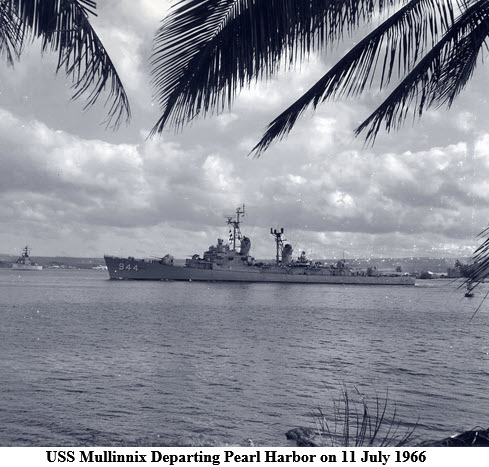
There was the "Brown-Water Navy" who had the job ferrying troops into battle sites, using the inland waterways that South Vietnam is combed with. They used small boats (there were many different types) that would ferry ground combat troops in or out of their area of operations. These men saved many, many lives by doing so because they too were under fire when they did so. Then there were other naval vessels, which dropped off recon teams in deep enemy area's, at a huge risk to themselves.
The "blue-water" navy did not (could not) engage the enemy at close range because their hulls touched bottom to easily, they were responsible for keeping literally thousands of pounds of enemy munitions and or general supplies from reaching the enemy. Former Marines take their hats off to those in the Navy that did help immensely in our ability to fight.
After a 3-month deployment with the 6th Fleet, the Mullinnix sailed for the western Pacific to aid the Vietnamese in their struggle against Communist tyranny. Between 2 August and 1 November 1966 she was intermittently deployed off South Vietnam, ranging from the DMZ to Saigon River, providing valuable gunfire support. This was during the Vietnamese Counter-offensive Phase II (01 July 1966 - 31 May 1967). She departed Subic Bay and sailed for the east coast, via the Indian Ocean and Suez Canal, arriving Norfolk 17 December.
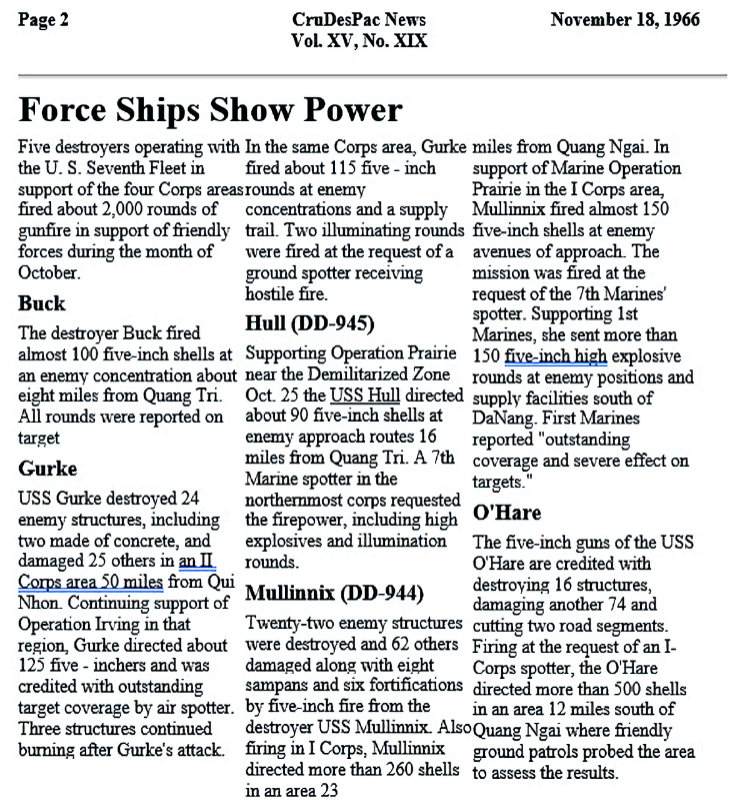
8 January, 1966
U.S. forces launch Operation Crimp. Deploying nearly 8,000 troops, it is the largest American operation of the war. The goal of the campaign is to capture the Vietcong’s headquarters for the Saigon area, which is believed to be located in the district of Chu Chi. Though the area in Chu Chi is razed and repeatedly patrolled; American forces fail to locate any significant Vietcong base.
February 1966
Hoping for head-on clashes with the enemy, U.S. forces launch four search-and-destroy missions in the month of February. Although there are two minor clashes with Vietcong regiments, there are no major conflicts.
5 March, 1966
The 272nd Regiment of the Vietcong 9th Division attacks a battalion of the American 3rd Brigade at Lo Ke. U.S. air support succeeds in bombing the attackers into retreat. Two days later, the American 1st Brigade and a battalion of the 173rd Airborne are attacked by a Vietcong regiment, which is driven away by artillery fire.
April-May 1966
In Operation Birmingham, more than 5,000 U.S. troops, backed by huge numbers of helicopters and armored vehicles, sweep the area around north of Saigon. There are small-scale actions between both armies, but over a three-week period, only 100 Vietcong are killed. The Vietcong, who prove elusive, dictates most battles.
Late May - June 1966
In late May 1966, the North Vietnamese 324B Division crosses the Demilitarized Zone (DMZ) and encounters a Marine battalion. The NVA holds their ground and the largest battle of the war to date breaks out near Dong ha. Most of the 3rd Marine Division, some 5,000 men in five battalions, heads north. In Operation Hastings, the Marines backed by South Vietnamese Army Troops, the heavy guns of U.S. warships and their artillery and air power drive the NVA back over the DMZ in three weeks.
30 June, 1966
On Route 13, which links Vietnam to the Cambodian border, American troops are brutally assaulted by the Vietcong. Only American air and artillery support prevents a complete disaster.
July 1966
Heavy fighting near Con Thien kills nearly 1,300 North Vietnamese troops.
October 1966
The Vietcong's 9th Division, having recovered from battles from the previous July, prepares for a new offensive. Supplies have replaced losses in men and equipment and reinforcements sent down the Ho Chi Minh trail from North Vietnam.
4 September, 1966
In a new mission code-named Operation Attleboro, the U.S. 196th Brigade and 22,000 South Vietnamese troops begin aggressive search and destroy sweeps through Tay Ninh Province. Almost immediately, huge caches of supplies belonging to the NLF 9th Division are discovered, but again, there is no head-to-head conflict. The mission ends after six weeks, with more than 1,000 Vietcong and 150 Americans killed.
18 Nov, 1966
USS John R. Craig DD-885 and USS Hamner DD-718 returned fire after being shelled by enemy shore batteries.
23 Dec, 1966
USS O'Brien DD-725 was hit by shore batteries north of Dong Hoi. This marked the first time a U.S. vessel took a direct hit since the beginning of the Vietnam conflict.
End of 1966
By the end of 1966, American forces in Vietnam reach 385,000 men, plus an additional 60,000 sailors stationed offshore. More than 6,000 Americans have been killed in this year, and 30,000 have been wounded. In comparison, an estimated 61,000 Vietcong have been killed. However, their troops now numbered over 280,000.
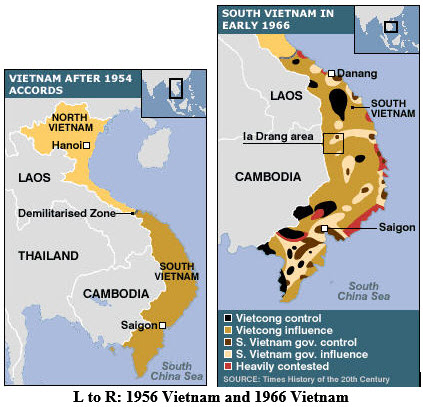
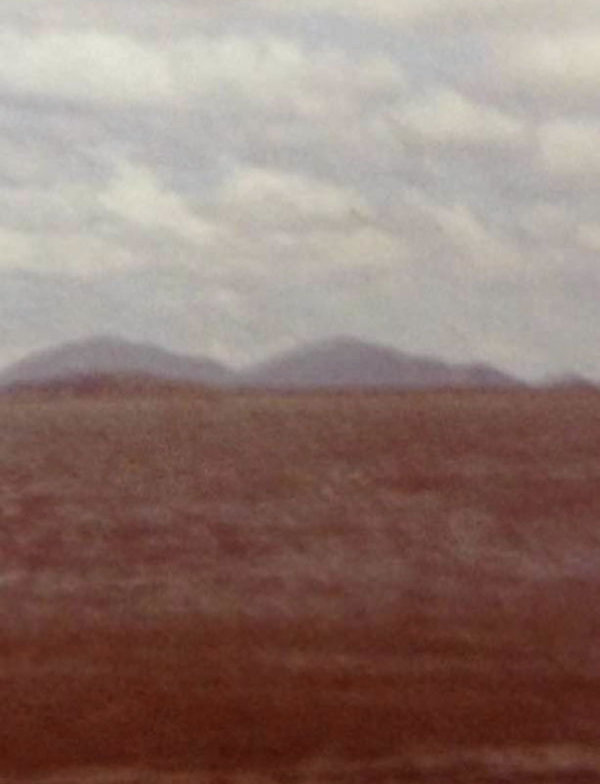
Entrance to Da Nang, South Vietna, Harbor
(1965 - not a Mux picture)
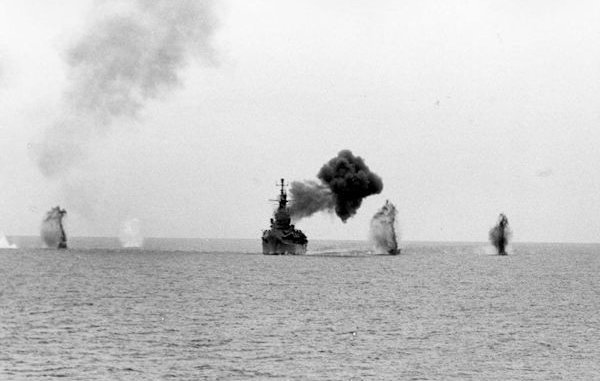
USS St Paul Under Fire of Coast of Vietnam
(1967 - not a Mux picture)
_______________
GO TO 1966 - Coming Home
GO TO Liberty Call Gitmo 1966
GO TO Liberty Call Balboa, Panama 1966
GO TO Liberty Call Manzanillo, Mexico 1966
GO TO Liberty Call Pearl Harbor 1966
GO TO Liberty Call Midway Island 1966
GO TO Liberty Call Guam 1966
GO TO Liberty Call Olongapo City 1966
GO TO Liberty Call Hong Kong 1966
GO TO Liberty Call Penang, Malaysia 1966
GO TO Liberty Call Cochin, India 1966
GO TO Liberty Call Aden, Yemen 1966
GO TO Liberty Call Athens, Greece 1966
Go Back to '66 Vietnam - Page 7
Go Back to '66 Vietnam - Page 6
Go Back to '66 Vietnam - Page 5
Go Back to '66 Vietnam - Page 4
Go Back to '66 Vietnam - Page 3
Go Back to '66 Vietnam - Page 2
Go Back to '66 Vietnam - Page 1
Go Back to Ship History
Home
© 2022 by Frank Wood, All rights reserved





